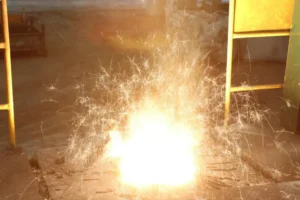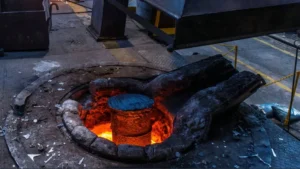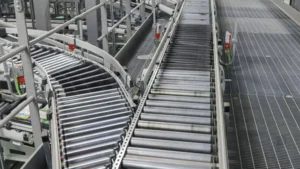Modern foundries are increasingly favoring induction furnaces primarily because they offer significant advantages in تحسين جودة الصب, achieving energy savings and emission reductions, and providing high operational flexibility. Compared to traditional cupolas or resistance furnaces, induction furnaces offer a cleaner, more controllable, and more efficient method of metal melting.
ميزة 1: Significant Improvement in Casting Quality
Induction furnaces fundamentally ensure the purity and stability of the molten metal through precise control and a unique melting process.
- التحكم في درجة الحرارة الدقيقة: The principle of induction heating allows for very precise and rapid adjustment of the molten pool temperature (accurate to within ±5°C). This is crucial for pouring specific grades of alloys, effectively preventing casting defects (such as cold shuts or misruns) caused by overheating or insufficient temperature.
- التحريك الكهرومغناطيسي: The induction current naturally creates an electromagnetic stirring effect in the molten metal. This stirring action offers two major benefits:
- Homogeneous Chemical Composition: It ensures that alloying elements (like carbon, السيليكون, المنغنيز, إلخ.) are uniformly distributed throughout the molten metal, preventing compositional segregation.
- Impurity Removal: The stirring action forces non-metallic inclusions (like slag) to float to the surface, making them easier to remove during deslagging, thus yielding purer molten iron or steel.
- Reduced Carbon Pickup and Contamination: Unlike cupolas (which use coke), induction furnaces provide “ينظف” ذوبان. The metal does not come into direct contact with fuel (like coke), avoiding unnecessary carbon pickup and contamination from harmful elements like sulfur and phosphorus during the melting process. This is particularly important for producing high-quality ductile iron, low-carbon steel, and special alloys.
ميزة 2: Outstanding Energy Savings and Emission Reduction (البيئة) Performance
Against the backdrop of increasingly strict environmental regulations and rising energy costs, ال “green” characteristics of induction furnaces are a core reason for their popularity.
- عالي الكفاءة الحرارية and Energy Savings: Induction furnaces directly heat the metal itself via electromagnetic induction, with heat generated داخل the material. في المقابل, traditional furnaces (like cupolas or reverberatory furnaces) must first heat the furnace chamber and then transfer heat to the metal via conduction and radiation, resulting in massive energy loss. The thermal efficiency of induction furnaces is typically much higher than traditional furnaces, significantly reducing energy consumption per unit of output.
- Drastic Reduction in Emissions:
- No Combustion Emissions: Induction furnaces use electricity, fundamentally eliminating the large volumes of harmful gases like CO₂, SO₂ (ثاني أكسيد الكبريت), and NOx (أكاسيد النيتروجين) produced by burning fossil fuels (like coke or heavy oil).
- Extremely Low Dust and Fume Levels: The dust and fumes generated during melting mainly come from metal vaporization and charge material adherents, which are far less than the massive amounts generated by combustion and air-blasting in a cupola. This greatly improves the foundry environment (both inside the workshop and outside the plant) and significantly reduces the investment and operating costs for dust collection equipment.
- Low Metal Burn Loss: Due to the fast melting speed and the relatively enclosed furnace mouth, the metal’s exposure time to air and oxidation is short. The metal burn loss rate (metal lost to oxidation) is very low, typically controlled at around 1%, which is much lower than the 3%-5% common in cupolas. This directly increases the metal yield and saves valuable raw materials.
ميزة 3: Unmatched Operational Flexibility
Induction furnaces are perfectly suited to the modern casting production demands of “دفعات صغيرة, high variety, and fast pace.”
- Rapid بدء/Shutdown and Intermittent Operation: An induction furnace can be “ready on demand.” It melts quickly (from a cold start to tapping typically takes only 1-2 ساعات) and is easy to hold at temperature or shut down. This allows the factory to schedule production flexibly based on orders and is ideal for intermittent operation, whereas a cupola, once “lit,” must be run continuously.
- Convenient Alloy Switching:
- Easy to Empty: The induction furnace can be completely tilted to pour out all the molten metal.
- No Cross-Contamination: This makes switching alloy grades (على سبيل المثال, from gray iron to ductile iron, or from common steel to alloy steel) very simple and fast. One only needs to empty the crucible, avoiding residual contamination from the previous batch.
- Adaptability to Various Charge Materials: Induction furnaces are highly adaptable to the charge, effectively melting everything from high-quality pig iron and steel scrap to cheaper machining chips and foundry returns. This helps the foundry optimize its charge material costs.
ملخص
Modern foundries choose induction furnaces because they comprehensively outperform traditional melting equipment in the three core dimensions of quality control (precise temperature, electromagnetic stirring for purification), cost and environment (high energy efficiency, no combustion emissions, low burn loss), و production scheduling (flexible start-stop, easy material changeover). It makes the casting process cleaner, more precise, and more economical, perfectly aligning with the direction of manufacturing upgrades and sustainable development.







